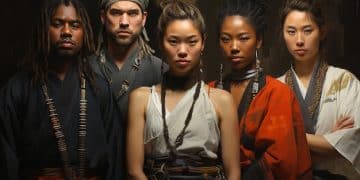From Page to Screen: Comparing Adaptations

Comparing the transition of narratives from written pages to cinematic or television screens reveals the intricate challenges and creative liberties involved in adapting a story for a visual medium, often highlighting how different interpretations can reshape audience perception.
Delving into the captivating world where literature meets visual storytelling, the journey from page to screen: comparing the intricate processes and diverse outcomes of adaptation offers a fascinating look at creative interpretation. Each transition involves distinct challenges and opportunities, shaping how beloved stories resonate with new audiences.
The Art of Adaptation: Challenges and Opportunities
Translating a compelling narrative from the silent pages of a book to the vibrant, dynamic world of film or television is an endeavor fraught with both artistic challenge and immense creative opportunity. The core difficulty lies in honoring the source material’s essence while simultaneously reimagining it for a different sensory experience. What works as internal monologue on paper might require visual metaphors or externalized action on screen.
Each medium possesses its own unique strengths and limitations. Literature thrives on introspection, detailed descriptions, and the reader’s active imagination. Cinema, conversely, excels in visual grandeur, sound design, and the immediate impact of performance. The adapter must navigate these inherent differences, often making difficult choices about what to preserve, what to alter, and what to omit entirely.
Retaining the Narrative Core
A primary goal for any adaptation is to capture the “spirit” of the original work. This isn’t always about a literal translation of every scene or line of dialogue, but rather about conveying the thematic heart, character arcs, and emotional resonance that made the source material powerful. Maintaining authenticity to the author’s vision, even through reinterpretation, is crucial for satisfying long-time fans.
- Thematic Fidelity: Ensuring the core messages and underlying themes remain intact.
- Character Integrity: Portraying characters in a manner consistent with their established personalities and motivations.
- Emotional Resonance: Evoking similar feelings and reactions in the audience as the book did in its readers.
However, the transition also presents unprecedented opportunities. Visual mediums can bring abstract concepts to life, provide a concrete setting for imagined worlds, and allow actors to embody familiar characters in new and exciting ways. This reinterpretation can deepen understanding, expose new facets of a story, or introduce it to a broader demographic unfamiliar with the original text.
Character Embodiment: Actors and Archetypes
One of the most profound shifts in moving a story from page to screen centers on the visual and auditory embodiment of its characters. In literature, characters exist primarily in the reader’s imagination, shaped by descriptive prose and internal monologues. Readers form unique mental images and vocalizations for each character, influenced by their own experiences and interpretations of the text. When these characters are cast and brought to life by actors, a definitive visual and vocal presence is established, which can either align with or starkly diverge from individual reader expectations.
This transition introduces a crucial layer of interpretation: the actor’s performance. An actor doesn’t merely recite lines; they inhabit a character, bringing their own understanding, physical nuances, and emotional depth to the role. This can illuminate previously subtle aspects of a character’s personality or backstory, or it can challenge long-held perceptions by introducing new dimensions. For instance, a character described as stoic in a novel might be portrayed with understated pain in a film, adding layers that prose alone might not fully convey.
Casting Challenges and Public Perception
The casting process itself is often a contentious point for fans of popular books. Every fan has a dream cast, and when the reality differs, it can lead to immediate criticism. The challenge for casting directors and filmmakers is to find actors who not only physically resemble the characters (where relevant) but can also genuinely capture their psychological complexity and thematic importance. Success in this area can lead to iconic performances that redefine how audiences perceive a character, solidifying their place in popular culture well beyond the original text.
- Physicality vs. Essence: Balancing physical resemblance with an actor’s ability to embody a character’s true nature.
- Fan Expectations: Navigating the strong, often passionate, opinions of dedicated book readers.
- Redefining an Archetype: The potential for an actor’s portrayal to become the definitive image of a character.
Furthermore, the visual nature of screen adaptations means that character traits that were purely internal or hinted at in a book become external realities. A character’s costume, mannerisms, or even the subtlest facial expressions can communicate volumes without a single word of dialogue. This allows for a deeper, more immediate connection with the audience, but it also places a greater reliance on the visual medium to convey elements that were once left to the reader’s imagination. The performances become the new benchmark for character interpretation.
Narrative Structuring: Pacing and Plot Compression
One of the most significant adjustments required during the adaptation process involves the fundamental restructuring of the narrative. Books often afford the luxury of extensive exposition, detailed backstory, and layered subplots that unfold over hundreds of pages. Films and television series, however, operate under different constraints, primarily time and the need for immediate visual engagement. This necessitates careful consideration of pacing and plot compression, often leading to difficult editorial decisions.
Filmmakers must condense complex plotlines, combine characters, or sometimes even omit entire narrative threads that, while enriching in a novel, might slow down the on-screen momentum or muddy the primary storyline. The challenge is to maintain coherence and character development despite these compressions. A novel might delve into a character’s inner turmoil over several chapters, whereas a film may have only minutes or a single montage to convey the same emotional arc, demanding visual shorthand and impactful performances.
Balancing Detail and Flow
The pacing of a story from page to screen is inherently different. A reader can control their pace, lingering on passages or rereading sections. A film or TV show dictates the pace, guiding the audience through the story at a predetermined speed. This means adapting a slow-burn mystery or a character-driven drama requires keen judgment on how to accelerate certain elements without sacrificing the story’s overall impact or emotional weight. Flashbacks, montages, and voice-overs are common tools used to convey information swiftly.
- Time Constraints: Adapting expansive narratives into limited screen time.
- Visual Shorthand: Using images and sounds to convey information quickly and efficiently.
- Maintaining Tension: Ensuring the plot remains engaging despite condensed storytelling.

Conversely, some adaptations choose to expand upon brief moments or minor characters from the source material, enriching the world or exploring a particular theme in greater depth. This expansion can be a risky but rewarding creative choice, providing new perspectives that even dedicated fans hadn’t considered. Ultimately, the ability to effectively streamline or expand a narrative while preserving its core integrity is a hallmark of successful adaptation, making the story work powerfully within its new medium.
Visualizing the World: Setting and Atmosphere
The transition from the imagined realm of a book to the tangible reality of a screen production profoundly impacts how the story’s world is perceived. In literature, authors meticulously craft settings through descriptive language, relying on readers’ imaginations to fill in the details. However, on screen, every building, landscape, and object becomes concrete, demanding a precise visual interpretation that can either enhance or alter the audience’s previous understanding of the story’s environment and atmosphere.
Production designers, costume designers, and cinematographers play a pivotal role in translating these textual descriptions into visual realities. They must decide on countless details: the color palette of a dystopian future, the architectural style of a fantasy kingdom, or the texture of period clothing. These decisions collectively contribute to the atmosphere, influencing the audience’s mood and connection to the story. A dark, muted color scheme might emphasize a somber tone, while vibrant, expansive landscapes can convey hope or adventure.
Interpretation and Authenticity
The goal is often to create a world that feels authentic to the source material’s spirit, even if it differs slightly from individual readers’ mental images. This might involve extensive research for historical dramas or intricate concept art for fantasy epics. The visual world-building must support the narrative, reflecting the characters’ experiences and the story’s themes. For example, a decaying manor might symbolize the decline of a family, a concept conveyed through descriptive prose in a book but through intricate set design and lighting in a film.
- Translating Description: Converting textual descriptions into tangible visual elements.
- Atmospheric Impact: How visual choices influence the emotional tone and audience experience.
- Creative License: The extent to which designers can interpret or reinterpret the original setting.
However, the transition also enables unparalleled immersion. Sound design, musical scores, and special effects combine with visuals to create an immersive experience that written text, by its nature, cannot fully replicate. The roar of a dragon, the murmur of a crowded city, or the chill of a vast, empty landscape become sensory realities. This complete sensory immersion allows audiences to become more deeply embedded in the story’s world, making the adaptation a powerful, collective imaginative experience that complements the solitary act of reading.
Dialogue and Inner Monologue: Speaking vs. Showing
One of the most profound stylistic transformations in adapting a novel for the screen lies in handling dialogue and, more critically, inner monologue. Novels frequently explore characters’ thoughts, feelings, and motivations through extensive interior narration, giving readers direct access to their internal lives. This allows for nuanced character development and complex thematic exploration that doesn’t always translate directly to a visual medium, where the emphasis is typically on showing rather than telling.
On screen, lengthy internal monologues can feel static or artificial. Filmmakers must find creative ways to externalize these internal states. This often means relying on visual cues—a subtle facial expression, a significant glance, a character’s body language—or translating thoughts into action or direct dialogue. A character’s internal conflict described over pages in a book might be conveyed through a tense conversation, a solitary walk, or a poignant musical cue in a film.
Transforming Internal Dialogue
Dialogue, too, undergoes a transformation. While screenwriters often lift lines directly from the book, they also frequently streamline, condense, or rewrite conversations to fit the flow and pacing of a visual narrative. What might be a lengthy philosophical debate in a novel might become a quick, impactful exchange that pushes the plot forward. The goal is to ensure that the dialogue sounds natural and authentic to the characters while also being efficient in conveying information and emotion.
- Visual Storytelling: Substituting internal narration with visual and auditory cues.
- Dialogue Efficiency: Condensing and refining conversations for screen pacing.
- Subtextual Communication: How unsaid things contribute to character and plot development.
Voice-over narration, while a direct way to retain a book’s internal monologue, is used sparingly in modern cinema as it can sometimes be perceived as a narrative crutch. When employed effectively, however, it can provide crucial insights or maintain a novel’s distinctive narrative voice. Ultimately, the challenge is to convey character depth and thematic complexity without the direct access to inner thoughts that literature provides. This pushes screenwriters and directors to be ingenious in how they “show” rather than “tell” the internal lives of their characters, often leading to powerful, layered performances that resonate deeply with audiences.
Audience Reception: Expectations and Judgments
The journey from page to screen inevitably places adapted works under intense scrutiny, particularly from the dedicated fanbase of the original novel. Audience reception is complex and multifaceted, shaped by a confluence of pre-existing expectations, individual interpretations of the source material, and the subjective qualities of the adaptation itself. This often leads to heated debates and strong opinions, where adaptations are judged not just on their cinematic merits but on their fidelity to the beloved text.
Readers form deep, personal connections with characters and worlds within books. When these intellectual landscapes are made tangible on screen, there’s an inherent tension between the collective vision presented by the filmmakers and myriad individual imaginings. A character’s appearance, a pivotal scene’s emotional weight, or even the overall tone of the story can provoke strong reactions if they deviate significantly from audience expectations. This creates a high-stakes environment for any adaptation team.
Navigating Fan Expectations
Successful adaptations often strike a delicate balance: honoring the essence of the original while taking necessary creative liberties to make the story work in its new medium. For some, strict fidelity is paramount; for others, a bold reinterpretation can be refreshing. The best adaptations manage to transcend these expectations, creating something that stands on its own merits while still feeling true to its roots. These are the adaptations that often convert new fans to the original source material and deepen the appreciation of existing ones.
- Fidelity vs. Innovation: The ongoing debate about how closely an adaptation should hew to its source.
- Emotional Investment: How pre-existing attachments to characters influence audience reception.
- New Audience Introduction: The role of adaptations in expanding a story’s reach.

The public discourse surrounding adaptations is also influenced by social media and review platforms, where opinions are shared instantly and widely. This amplified conversation can greatly impact a film or series’ initial momentum. Ultimately, audience reception serves as a critical barometer, not just for the success of an adaptation, but also for understanding the evolving relationship between literature and its cinematic counterparts, revealing what makes a story truly timeless across different media.
The Evolution of Storytelling: A Symbiotic Relationship
The ongoing process of translating stories from page to screen is not merely a one-way street, but rather a dynamic and symbiotic relationship that continually influences and evolves both literary and cinematic storytelling. As technology advances and creative approaches diversify, adaptions have become more than just derivative works; they are often pivotal moments in a story’s lifecycle, introducing it to new generations and mediums.
Modern adaptations benefit from sophisticated visual effects that can bring even the most fantastical literary worlds to life with unprecedented realism. This visual capability has, in turn, inspired authors to write with greater imaginative scope, knowing that their intricate worlds might one day find a home on screen. The success of large-scale adaptations, such as expansive fantasy series, has also demonstrated the commercial viability of complex narratives, encouraging publishers to invest in epic stories.
Future Trends and Interdisciplinary Creations
The increasing prevalence of streaming services has further blurred the lines between film and television, offering new formats for adaptation, such as limited series that can delve deeper into a book’s narrative than a two-hour film. This extended canvas allows for more comprehensive character development and plot exploration, often satisfying fans who desire a more complete and faithful rendition of their favorite novels. The rise of transmedia storytelling also means stories are increasingly designed from the outset to exist across multiple platforms.
- Technological Impact: How advancements in visual effects influence adaptation possibilities.
- Streaming Era: The role of streaming platforms in fostering diverse adaptation formats.
- Transmedia Narratives: Stories designed for cross-platform expansion from inception.
Ultimately, the continuous push to bring literature to life on screen fosters a deeper appreciation for both art forms. It encourages new readings of classic texts and provides fresh perspectives on contemporary works. This evolution ensures that compelling narratives, whether born on the page or designed for the screen, continue to captivate audiences, highlighting the enduring power of storytelling in its myriad forms and reinforcing the intricate, evolving connection between written and visual arts.
| Key Aspect | Brief Description |
|---|---|
| 📖 Narrative Core | Maintaining the original story’s essence and themes. |
| 🎭 Character Portrayal | Actors embodying written characters, influencing perception. |
| ⏱️ Plot Pacing | Condensing or expanding story rhythm for screen flow. |
| 🌍 World Visualization | Bringing imagined settings to life with sensory details. |
Frequently asked questions
▼
The main challenges involve condensing lengthy narratives, externalizing internal monologues, and visually representing character descriptions. Filmmakers must also balance fidelity to the source material with the need for creative interpretation to make the story work effectively in a visual medium, often navigating strong fan expectations while doing so.
▼
Filmmakers primarily use visual storytelling techniques to convey inner thoughts. This includes subtle facial expressions, body language, strategic camera angles, and sound design. Sometimes, voice-over narration or significant dialogue exchanges are employed to externalize a character’s internal state, ensuring the audience grasps their motivations without explicit internal monologue.
▼
Changes are often made to suit the demands of the visual medium, such as pacing, budget, and runtime limits. Elements might be altered to enhance dramatic effect, simplify complex plots for a broader audience, or update themes to resonate with contemporary viewers. These decisions aim to optimize the story for screen presentation, making it accessible and engaging.
▼
Casting is critically important as actors give definitive visual and vocal representations to characters previously only imagined. Their performances can elevate a story, capturing the essence and complexity of the characters in ways that resonate deeply with audiences. Successful casting can also greatly influence audience acceptance and enjoyment of the adaptation as a whole.
▼
A successful adaptation typically strikes a balance between loyalty to the source material’s core spirit and innovative reinterpretation for the screen. It should capture the thematic integrity and emotional resonance of the book while leveraging the unique strengths of a visual medium, creating an engaging and satisfying experience for both fans of the original and new audiences.
Conclusion
The intricate journey from page to screen: comparing the myriad decisions and creative interpretations involved in adapting a narrative is a testament to the dynamic nature of storytelling. It is a process that demands both reverence for the original text and bold innovation to thrive in a new medium. Ultimately, the best adaptations not only honor the literary foundation but also forge their own distinct identity, enriching the cultural landscape by making cherished stories accessible to new audiences while deepening the appreciation for the craft of both writing and filmmaking. This fascinating interplay ensures that the magic of storytelling continues to evolve, captivating imaginations across diverse platforms and generations.





